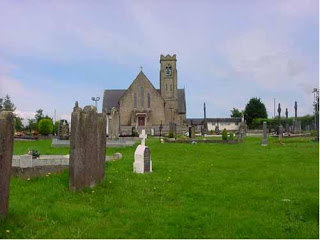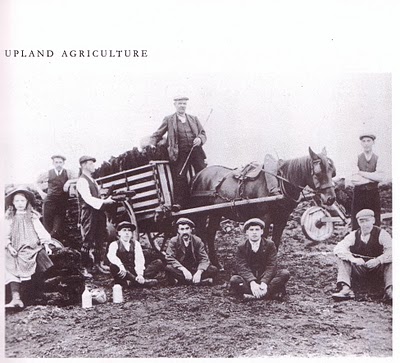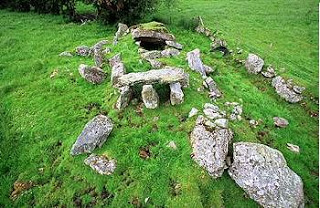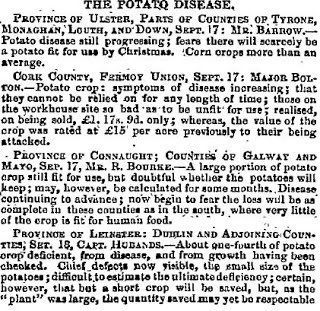Original Rootsweb Co. Tyrone Community Site
Dunamore, Kildress Parish History & Monaghan Family to England & Back to Ireland
The Papists of Kildress Co. Tyrone
1766
The list of the ‘Papists of the Parish
of Kildress 1766’ shows that out of the 22 Catholics in the townland of
Dunamore, County Tyrone, eight were O’Monaghans (there were no
O’Monaghans elsewhere in the parish). These people, it seems, were heads
of households, as the only women listed are widows, who would have been
the heads of their households. There were three McGeraghtys in the
townland of Strawmagilmartin*, and one in the neighbouring townland of
Beagh More (and none elsewhere in the parish). As is shown below there’s
little doubt that our ancestors were amongst these Monaghans and
McGeraghtys but at the moment it’s not clear which of these people were
our direct ancestors. We’re
lucky to have this information as most returns of this religious survey,
which was carried out by Church of Ireland vicars on the instructions of
the government, have been lost.
The Tithe Applotment Survey of 1827
Two 19th century land valuations of
Kildress parish give details of people renting (or owning) land in
Dunamore. In 1823 the
Composition Act specified that tithes to the established church should
now be paid in money, rather than in kind. Tithes were a great bone of
contention as they had to be paid by the entire population including
Catholics and Presbyterians, not just by members of the Church of
Ireland. The Tithe Applotment Survey of December 1827 and Griffith’s
Valuation of Ireland of 1860 show a concentration of Monaghans in the
townland of Dunamore, and of McGeraghtys in the nearby townland of
Kinnagillian. Both these
surveys list only those individuals, usually heads of household, who
rented land. The T A Books reveal the land in Dunamore to be poor.
Due to the destruction of many Irish records, including all the census
returns up to 1901, these land surveys are of great importance to those
tracing their family history.
The Tithe Applotment Survey of 1826
showed 40 people renting (or owning) land in Dunamore; ten of these were
Monaghans. It seems the surname had been modified from O’Monaghan to
Monaghan. There was a Michael Monaghan (not our Michael who would only
have been 11 in 1826), Francis
Monaghan (possibly Michael’s father as he named his eldest son
Francis), two Peters, two Patricks, a Widow Monaghan, James,
John, and a Bartholomew Monaghan.
It seems fairly unlikely that either
Peter or Bartholomew were direct ancestors as neither of these names
crops up in any subsequent generation of our family, though they do
occur in Monaghan families found in Berry Edge and Port Clarence.
*A book on the Surnames of Ireland
refers to the Gaelic surname Mac Giolla Mhartain - follower of St
Martin; I wonder if this forms part of the derivation of
Strawmagilmartin?
Some Monaghan families in Kildress
1841-51
Censuses began in Ireland only in 1821
and none was taken in 1881 or 1891.
The returns for 1861 and 1871 were destroyed by government orders
and most of those for 1821-1851 were lost in the 1922 fire during the
Irish Civil War. An Old Age
Pension for Senior Citizens was introduced in Ireland in 1908 and, to
verify claimants' eligibility from 1910 to 1922, officials at the Irish
Public Record Office abstracted information from the 1841 and 1851
census returns onto "Green Forms" for government internal use. These
Green Forms survive in the National Archives, filed by county and
parish, for the families that were searched.
The green forms give the following
information about the Monaghans of Kildress.
In 1841 amongst the Monaghan families in the townland of Kildress
were Joseph Monaghan, and his wife Jane (her maiden name seems
also have been Monaghan), James, 8 in 1841 made a claim for a pension at
Dunamore in 1909. Charles
Monaghan claimed a pension in 1916, this revealed that in 1841, when he
was 16 months, he lived with his parents, Patrick and Bridget (Loughran)
at Beleevna Beg, near Dunamore.
Catherine Conway (formerly Monaghan) claimed a pension in 1921.
Her green form shows her parents and siblings in 1851, Michael
(35) and Bridget (23) Monaghan, Alice (9½,) James &, Mary (3), Bridget
(2), and Ann (3 months) at Dunamore.
Also in the district in 1841/51 were Terrance and Mary Monaghan
and their family. Christopher
Keenan and his wife Bridget (Monaghan), appear on the record of their
daughter Ann Loughran’s pension claim; Christopher and Bridget of
Meenanea had a number of children baptised between 1837 and 1849 at St
Mary’s Dunamore.
Dunamore School and Monaghan teachers
In 1828 a school was opened at
Dunamore and in 1834, teaching the 39 pupils (including eight girls) was
Mick Monaghan, who was paid £4 0s 0d every six months. In 1834 Joe
Monaghan was commissioned to provide a new name board for the school. In
February Terence Monaghan submitted a petition on behalf of parents,
criticising the conduct of the school under Mick Monaghan, who was
allegedly absent from school three days a week running a shop. By 1
September 1838 John Monaghan had been installed as a school master; he
was apparently a most competent school master. In the 1880’s John J
Monaghan was the school master, assisted by his sister Kate.
In November 1869 an Anne Monaghan,
‘the widow of Michael Monaghan, school master’, died at Stockton St
Middlesbrough*, in 1851 she was
the head of a household of six at 167 Berry Edge, (Consett, Co Durham).
The census of 1891 shows her children were born in Kildress.
St Mary’s Blackhill baptism register shows her maiden name to be
McNamy. The GVI survey of
Dunamore in 1859 shows several McNamees in the area.
No doubt the Dunamore Monaghans were
interrelated, but it’s unlikely that we will never know if or how these
individuals were related to
Michael Monaghan; much of
information comes from the book ‘Kildress Rolling back the Brambles’
The Kildress parish Register
The Kildress parish register can be
viewed on microfilm at the Public records Office of Northern Ireland in
Belfast. The quality of the
ink, the handwriting and poor standard of filming make this register
difficult to read. Also Irish
registers of this period often offer less information than their English
contemporaries and this register is no exception, the parents of the
brides and grooms are not recorded, though the townland they lived in
is; the names of the sponsors hint at the kith and kin of each of the
families.
In 1835 Patrick Monaghan, son of
Joseph Monaghan and Janet (Loughran) of Dunamore, was baptised, sponsors
Joseph Monaghan and Bridget McNamee.
Michael and Hannah Monaghan
Dunamore Catholic Church
The tower (absent from the old photo below) was added after the church
was built.
Family tradition has it that
Michael Monaghan; (my great
great Granda) came from Cookstown in County Tyrone.
We know from tracing the family back through English civil and
catholic church records to the 1851 census of England that
Michael was born around
1816 and that my great great gran,
Hannah McGeraty, his wife,
was three years older than him, and that their first child Bridget was
born around 1846, all in Ireland.
The parish register of Kildress
Catholic Church, St Mary’s, Dunamore (about eight miles from Cookstown,
just north of the Cookstown to Omagh road) records the marriage of
Michael Monaghan to
Honora McGeraty on 29
January 1846, witnesses Charles Mulhatton and Alice Monaghan, Dunamore.
Michael and
Hannah’s first child,
Bridget Monaghan, was baptised on 20 October 1846. This accords with the
information on the 1851 Census for Berry Edge (Consett) and confirms
this is ‘our’ Monaghan family*. The sponsors at the baptism were William
Monaghan and Sarah D.....*(illegible) it is likely that William, the
child’s godfather, was Michael’s brother. The family were living at
Dunamore. Because the names of
the fathers of the bride and groom were not recorded in the parish
register (contrary to the practice in England), it’s not possible at the
moment to positively identify our earlier ancestors. However, based on
the subsequent naming of the Monaghan children**,
Michael’s father may well
have been called Francis, perhaps the Francis Monaghan who appears on
the 1826 returns (plot 2).
Michael’s mother could well have been called Mary. Similarly Hannah’s
parents were likely called William & Bridget McGeraty.
The parish records for Dunamore Catholic Church are available on
microfilm at the public records office of Northern Ireland in Belfast.
Before finding these records I had checked five other Catholic
Parishes in the area without success.
* Possibly Donnolly; there was a
Donnolly family in Dunamore in 1826
**In
the past children were usually named after their grandparents: first son
- paternal grandfather, first daughter - maternal grandmother, second
son - maternal grandfather, second daughter - paternal grandmother.
On 1st December 1847 an Alice Monaghan
of Dunamore married Peter Cassidy. The witnesses were Edward and Patrick
Monaghan. It is very likely
that these people would have been relatives of
Michael Monaghan, possibly
brothers or sisters, or perhaps cousins.
The following baptisms took place at St Mary’s Dunamore.
Patrick and Ann (McGarrity) Corey of Beltonanean had a number of
children baptised in the period 1879 – 1893. Patrick and Bridget
(Monaghan) Donley of Dunamore had their son Michael baptised on 30 Sept
1836. Patrick and Margaret (Monaghan) Donnelly of Dunamore had their
children baptised, Catherine on 24 January 1849 and Margaret on 18 Sept
1842. Francis and Bridget (Monaghan) Keenan of Dunamore had three
children christened between 1854 and 1865.
James and Mary (Monaghan) McHugh of Dunamore had three children
baptised between 1832 and 1853. Patrick and Catherine (McGarritty)
McKenna of Killucan had six children baptised between 1836 and 1852. As
with the people referred to earlier it’s not known how or if these
people were related to our ancestors, but as well as sharing surnames
with then they lived in the same small area as our Monaghans and
McGerritys and it seems very likely they were related.
A description of the parish of
Kildress written in 1833 reads
as follows:
‘It is a mountainous district,
particularly the Northern part of the Parish [including Dunamore MB]
which presents a very bleak and wild appearance. The mountain land is of
a sharp gravelly nature yielding but very indifferent crops of oats and
potatoes. The average mountain crops about 3 bushels of oats, or 125
bushels of potatoes per acre. The land is manured with stable dung and
lime, but very little lime is used in the mountains. It is usual for the
inhabitants to take turf to Cookstown, a distance of perhaps 6 or 8
miles, and to load back with lime. The country is not thickly populated.
The inhabitants in the mountains are for the most part Roman Catholics
speaking the Irish language. They are for the most part very poor. ‘
Ordinance Survey Memoirs C Bailey
Lieutenant Royal Engineers, Oct. 30th 1833’
The 1901 census of Ireland shows a
picture that had changed, but not as much as might have been expected.
Twelve of the households in Dunamore were headed by Monaghans.
Like the other inhabitants of the townland there was a general
absence of people over 60.
Approximately half of the Monaghans spoke Irish, though in a change from
the position in 1833 they all could speak English.
A high proportion of the people in the townland could not read or
write. Everyone in the townland
was catholic.
The diet in pre-famine Ireland was
limited; this account comes from Co Mayo.
’They had few cattle or sheep as they
had little place to keep them.
Most families owned a cow and a calf only and those near the mountain
owned a few sheep each. The
land supported the household for they lived on potatoes and, now and
again, had oatmeal cakes and butter and milk. The corn was sold to pay
the rent and taxes. Flax was sown, a few quarts by each farmer, out of
which they made their linens, and wool provided the heavier clothing
which also was made locally.
Bed clothes were torn up and used as
clothing. Men wore short knee breeches, long tailed coats, high hats,
white linen shirts, long stockings and nailed boots. Women wore a cloak
with a white lined head cloth.’ Prefamine Echoes Cathal Poirteir
Cutting turf in Upper Weardale, Co Durham
a
similar Scene, I imagine, to that in Dunamore.
The Freeman’s Journal and Daily Commercial Advertiser [of Dublin] of 25
May 1832 carried the following article,
‘Protestant Liberality’
“We have been requested to state, and take great pleasure in doing so;
that at the Easter Vestry, held in the Parish church of Kildress County
Tyrone, the sum of £50 was unanimously voted for repairing the old Roman
Catholic Chapel of that parish.
The same sum was also granted by the vestry of 1831, for furnishing a
new Presbyterian meeting house.......This is as it should be and we only
regret that instances of similar liberality and good feeling are so rare
in this distracted and divided country. “
Another description from the same
period says the Catholic Chapel is ‘situated in the Townland of Dunamore,
erected in the year 1828 [the year before Catholic Emancipation], paid
for by subscription, cost about £60. It would accommodate about 60
persons, the full number generally in attendance. The scenery is
mountainous and the northern and western part of the parish is a large
tract of wild mountain, with nothing but a few miserable cabins, and
small patches of cultivated ground to relieve it’.
(Lewis’ Topographical
Dictionary of Ireland 1837)
A feature of Dunamore are the
neolithic graves in the area.
The nationalist newspaper, 'The
Nation' reported the handing over of a donation of 5s at a repeal
meeting in Dungannon by Mr Barker of Kildress, from the 'thoroughly
nationalist people of his parish' (30 November 1844.
At the same meeting Mr Michael Keilty also handed in 5s from the
parish of Kildress.
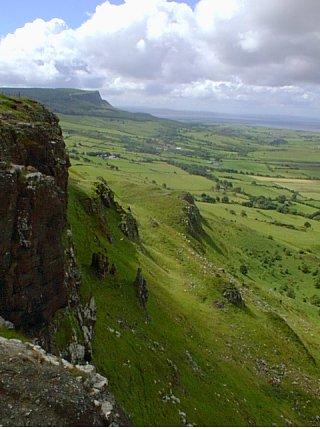
The Sperrin Mountains,
just north of Dunamore.
Emigration to England, and return to
Ireland.
|
Newcastle (upon Tyne)
Courant of Friday 5 February 1847
THE FAMINE IN IRELAND
...A malignant fever has broken out at the work house of
Dungannon, County Tyrone.
A great number were dying.
The physician was carried off by it in nine days, and
the last account states that the master and the mistress
were both ill of the same disease.
It is called a black fever.
The (Manchester) Guardian
7 October 1848
|
|
Shortly after Bridget’s birth her
parents decided they had to leave Ireland (where over a million people
were to die of starvation over the next few years).
The country’s population, which had risen to 8.2 million by 1841,
was almost halved over the next 50 years. The population of Kildress
parish, which totalled 7,600 in 1841, had dropped by 15% to 6,400 by
1851. By 1891 there were
4,500,000 people in Ireland, and 3,000,000 Irish-born people outside of
the country. Numbered amongst
these were all the known ancestors of the Monaghans, the Corrs (and the
Burns). The Tyrone potato crop had partially failed in 1845, and a year
later it failed totally. The potato was the staple food of most of the
population, and famine combined with heavy snow from November to
February 1846 to make the situation even more serious.
Sometime between October 1846 and 1848
Michael Monaghan and his
family sailed to England, likely to Whitehaven, and then probably walked
towards County Durham. The rail
fare from Carlisle to Newcastle at 1841 fares was 11s in a closed, or
8/6d in an open car, a miner earned £1 (20 s per week).
The most direct route from Cumbria to Durham was over the
watershed at Alston and down Weardale.
The 1851 census shows a house with many Irish boarders at
Nenthead at the top of the dale.
Despite this there were few Irish inhabitants in the upper dale,
as the organisation of the lead mining industry did not lend itself to
the employment of newcomers, I assume the Nenthead Irish were in transit
across the pennines.*
Continuing down the dale Irish travellers would have found themselves in
Wolsingham and then in Tow Law.
Perhaps the Monaghans had friends or relatives who were already in
Durham, and knew work was to be had there.
By October 1848, carrying a small
baby, and with another on the way they had covered the 40 miles to Tow
Law, a booming** iron, coal and
coke town, which was becoming a magnet for people arriving from Ireland.
‘Thornley’ was expanding by 1842; there was a valuable coal field and
the new rail connections (there was an appeal to raise funds to build a
church in the Newcastle Courant of 4 Feb 1842).
Charles Attwood had set up a major Iron works in Tow Law in 1845.
*Lead mining was carried on by local
families organised in self employed partnerships, there were no wages,
the men were paid for the lead they produced, they were paid only once
or twice a year, incomes were a fraction of those in the collieries, and
survival was only possible if the families had access to farming land
which was worked by the wives.
**Tow Law’s population grew from 30 in
1841 to 1,930 in 51 and 4,978 in 1861.
The population of the town dropped after the closure of Attwood’s
Iron works and his Engine works in the 1880s.
At the towns height there were 35
pubs, but as in Consett, beer was easier to come by than water in Tow
Law…‘The water supply at Tow Law
in the early days was very bad. Sometimes the women had to stand for two
hours to get a bucket of water. It used to be hawked in a water barrel
and sold at ½d a bucket… In those days they got hot water from the
standing engine at the bottom of the slag heap…
The water tank at the corner of Martin’s Bank used to close at
one o’clock on a Saturday. After that there was a stampede for water’.
(Memoirs of Tow Law Newrick Grant)
|
TO JOINERS
WANTED, a number of
Joiners at Tow Law
Iron Works near Wolsingham.
Good hands
Will meet with Liberal
Wages.
Apply to C Ritson Builder
Tow Law
Advert in the Newcastle
Courant of Friday 13 February 1846 illustrating the grown of
the town.
|
|
Greenhead was an original Iron Ore, pit for the furnaces of
Tow-Law, in 1840 [sic]. There were no surface workings, and
during the years 1865-1897, it was worked on a small scale,
by drift work. (Northern Mining Roots Bernard McCormick)
|
*Tow Law Durham Miner Project website.
** However the bank took no payment
for it’s efforts and –‘the British Association for the Relief of Extreme
Distress in Ireland and Scotland, founded by Stephen Spring Rice, Lionel
de Rothschild and Thomas Baring (of Baring's bank) in January 1847,
raised huge sums of money from the generosity of the wealthier classes
in England’. Rev Donal Kerr.
VCCS ‘The Catholic Church and the Great Famine’.
Michael found a labouring
job, and on 30 October 1848 Mary, the first English born Monaghan, was
born at Mechanics’ Cottages (now Baring Court), Tow Law, just east of
the Iron Works the terrace parallel with High Street at its southern
junction with Bridge Street (both streets now
form the A68 with the
War Memorial at their junction).
Mechanics’ Cottages was built in the original expansion of Tow
Law from a village to a town in the
1840’s.
The street’s name
was later changed to Baring Street, named after Bishop Baring, a member
of the banking family who financed the building of the iron works.
Coincidently Barings Bank was involved in the inadequate famine
relief efforts which did take place in Ireland.**
Mechanics cottages was a double row of well-dressed stone homes.
There were a total of thirty-five homes built in three rows. Between the
rows were single earth closets (toilets) flanked on either side by
coalhouses and shared by two families. Each house was a one up one down
with a large living room downstairs and one bedroom upstairs. There was
no bathroom or running water, no kitchen and all cooking was done on an
open fire or cast iron range with a boiler at the side for hot water*’
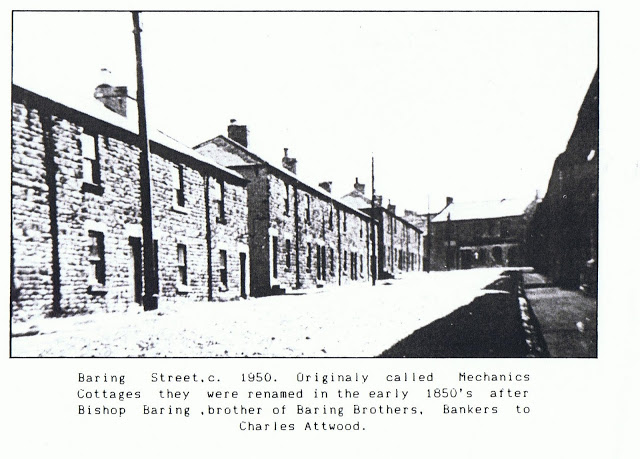
In
1851 over half the people in Mechanic’s Cottages at the south end of the
town had just arrived from Ireland and in Wolsingham Parish 265 out of a
population of 4586 or about 5% were Irish born.
The census gave the counties of origin of a very small sample of
the Irish population. There
was 1 person from Co. Antrim, 3 people from Co.
Armagh (including 2 from Carrick – likely Carrickfergus), 2 Down,
2 Dublin, 11 Fermanagh, 2 Galway, 5 Louth, 3 from
Co. Monaghan, 4 Sligo, 1 Gerrvagh Parish, on the Co Sligo – Co.
Roscommon border and just 1 from Co. Tyrone.
The prominence of Louth,
Armagh and Monaghan this small sample indicates a similar picture to
that in Consett at the time of the census, however, the registers of St
Thomas Wolsingham and Brooms Leadgate show that there was a significant
presence of Tyrone people in the area, many from Kildress and Dunamore.
St Joseph’s Catholic Church, Tow Law, was not established until 1867 and
St Thomas of Canterbury, Wolsingham, had been established in 1849.
Despite checking the baptism registers for Brooms and Esh Laude Mary’s
baptism has not been found. It has been suggested that she may have been
baptised at Bishop Auckland, though this is quite a long way from Tow
Law; anyway, the early records of St Wilfred’s, Bishop Auckland, have
been lost. Francis’ birth
certificate records that he was born on the 30 August 1850 at Mechanic’s
Cottages. Francis’ birth was
reported on 26 September that year.
Francis’ surname was recorded as Monighin, and Hannah’s maiden
name Garity. Francis was
baptised at St Thomas of Canterbury, Wolsingham on 8 September 1850, and
his date of birth is recorded as 31 August.
The sponsors were Michael Quinn and Mary Whittonhall.
Mary Whittonhall was the housekeeper to Thomas Wilkinson the
Catholic priest at Back Lane off Angate Street in Wolsingham.
There were two Michael Quins in northwest Durham at the time of
the 1851 census, both Irish as one would expect.
One was an agricultural labourer at Ford, near Maiden Law,
Lanchester; the other was a blast furnace labourer, one of a mainly
Irish household at Dan’s castle Tow Law, which also included two
Locherans, like Quin, a common name in Kildress, the home parish of the
Monaghans, in Co Tyrone. It
seems quite likely that Francis’ godfather, Michael Quinn, came from the
same Irish parish as his parents.
The dates of birth of Mary and Francis
suggest the family was in Tow Law for at least two years, moving to
Consett between the autumn of 1849 and the spring of 1851 when the
census was taken.


